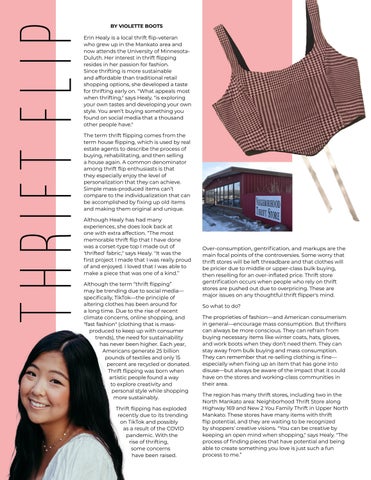BY VIOLETTE BOOTS
Erin Healy is a local thrift flip-veteran who grew up in the Mankato area and now attends the University of MinnesotaDuluth. Her interest in thrift flipping resides in her passion for fashion. Since thrifting is more sustainable and affordable than traditional retail shopping options, she developed a taste for thrifting early on. “What appeals most when thrifting," says Healy, "is exploring your own tastes and developing your own style. You aren’t buying something you found on social media that a thousand other people have." The term thrift flipping comes from the term house flipping, which is used by real estate agents to describe the process of buying, rehabilitating, and then selling a house again. A common denominator among thrift flip enthusiasts is that they especially enjoy the level of personalization that they can achieve. Simple mass-produced items can’t compare to the individualization that can be accomplished by fixing up old items and making them original and unique. Although Healy has had many experiences, she does look back at one with extra affection. “The most memorable thrift flip that I have done was a corset-type top I made out of 'thrifted' fabric," says Healy. "It was the first project I made that I was really proud of and enjoyed. I loved that I was able to make a piece that was one of a kind.” Although the term “thrift flipping” may be trending due to social media— specifically, TikTok—the principle of altering clothes has been around for a long time. Due to the rise of recent climate concerns, online shopping, and "fast fashion" (clothing that is massproduced to keep up with consumer trends), the need for sustainability has never been higher. Each year, Americans generate 25 billion pounds of textiles and only 15 percent are recycled or donated. Thrift flipping was born when artistic people found a way to explore creativity and personal style while shopping more sustainably.
46
Thrift flipping has exploded recently due to its trending on TikTok and possibly as a result of the COVID pandemic. With the rise of thrifting, some concerns have been raised. NORTH KATO MAGAZINE SPRING 2022
Over-consumption, gentrification, and markups are the main focal points of the controversies. Some worry that thrift stores will be left threadbare and that clothes will be pricier due to middle or upper-class bulk buying, then reselling for an over-inflated price. Thrift store gentrification occurs when people who rely on thrift stores are pushed out due to overpricing. These are major issues on any thoughtful thrift flipper's mind. So what to do? The proprieties of fashion—and American consumerism in general—encourage mass consumption. But thrifters can always be more conscious. They can refrain from buying necessary items like winter coats, hats, gloves, and work boots when they don’t need them. They can stay away from bulk buying and mass consumption. They can remember that re-selling clothing is fine— especially when fixing up an item that has gone into disuse—but always be aware of the impact that it could have on the stores and working-class communities in their area. The region has many thrift stores, including two in the North Mankato area: Neighborhood Thrift Store along Highway 169 and New 2 You Family Thrift in Upper North Mankato. These stores have many items with thrift flip potential, and they are waiting to be recognized by shoppers' creative visions. "You can be creative by keeping an open mind when shopping," says Healy. "The process of finding pieces that have potential and being able to create something you love is just such a fun process to me.”







